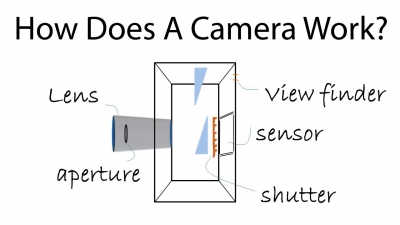
A camera is a fairly simple piece of equipment in its basic structure. One must not be put off by the numerous levers, buttons, scales and other gadgets on the outsides. These are all extremely useful aids but are not completely essential.
The essential part of the machine is what gives its name: the camera obscura. This is Latin for dark room. Photographs are produced when rays of lights penetrate into this dark chamber. The light must enter through a small opening and strike against a sensitive film. The surface of the film is covered in an emulsion of chemicals which capture the images being carried by light rays. The small opening, or aperture, must also be able to open the aperture to let the light in. this mechanism is called the shutter. In a simple camera this is about the only moving part.
In more expensive cameras the fitting includes mechanism which can vary the exposure time which determines how long the shutter will stay open. The can range from a thousandth of a second for fast-moving subjects to one second or more for still dimly-lit scenes. Other controls include an aperture selector to vary the amount of light passing through the lens, and a focusing mechanism to produce a sharp image.
The camera obscura has long been known to man and Leonardo da Vinci made accurate drawings of it in the fifteenth century. It was not until 1839, however, that the first commercially available cameras were made in Paris by Alphonse Giroux for Daguerre.
Picture Credit : Google

